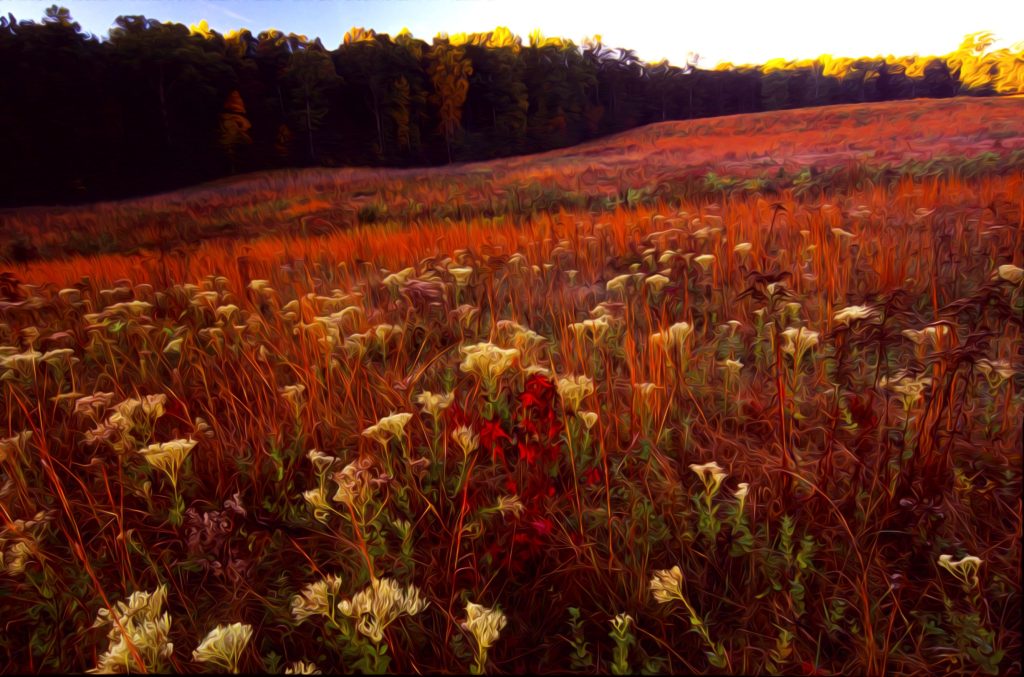A Thousand Words a Battle: Wilderness
Saunders Field, Battle of the Wilderness
May 5-7, 1864

The opening engagement of the battle of the Wilderness—indeed, of the entire 1864 Overland Campaign—began on the morning of May 5, 1864, in an open space called Saunders Field, but the fight quickly stretched into the forest that pressed in on either side. Among the Union soldiers trying to advance through the dark, close wood were the men of the 188th Pennsylvania, the “Corn Exchange Regiment,” in the brigade of Brig. Gen. Joseph Bartlett.
“General Bartlett was as conspicuous in this engagement as he always was in every battle. . . .” one member of the regiment recalled. “During this engagement he made a very narrow escape. He had ridden in to the thickest [thickets?] and suddenly found himself in close proximity to a considerable body of the enemy, who made him a target for their rifles.”[1]
A member of the 20th Maine, also in the brigade, watched as Bartlett burst from the forest into Saunders Field, “not twenty rods from the rebel line,” to try and make his escape:
He was on horseback; not a staff officer was with him; his uniform was torn and bloody; blood was trickling from several wounds in his face and head. . . .The rebels saw him, the moment he emerged from the forest, and called upon him to surrender, while a wild yell rang along their line as they saw their fancied prize.
But they did not know the man with whom they had to deal. Shaking his fist at them in defiance, he put spurs to his horse and dashed away. He was a target for every rifle in the rebel line. Five hundred guns were pointed at him, and five hundred bullets whistled around him, the enemy pursuing as they fired. It was a brilliant ride for life, with all the odds against the daring rider. Bravely he rode in the midst of that storm, as if death had no terror for him. His steed was a noble animal. . . . Each seemed to bear a charmed life.
Over one-half the distance across that field had been passed, and yet . . . [a] deep ditch must be crossed before they could gain the cover of the forest. A ditch dug many years before, five or six feet deep, and ten or twelve in width. The rebels knew the ditch was there, and sent up a wild yell of delight, as they fancied the officer would be delayed in crossing, and so fall into their hands.
The horse and rider evidently saw the obstacle at the same moment and prepared to meet it. Firmly the rider sat in his saddle, and gathered the reins of his horse with a firm hand. I never beheld a nobler spectacle than that presented by the gallant steed—his nostrils dilated, his ears pointed forward, his eyes seeming to clash with the fire of conscious strength as he made the fearful leap. For a moment I thought they were safe, but rebel bullets pierced the horse, and turning a complete somersault he fell stone dead, burying the rider beneath him as he fell.
Again the rebels cheered and rushed on, but to my surprise, the officer, with the assistance of a few wounded soldiers, extricated himself from his dead horse, ran across the edge of the field, and made his escape.[2]
The Pennsylvanian later reported of Bartlett, “His horse was killed, part of his clothing was shot away, but he fortunately escaped with a few bruises.”[3] Bartlett served out the rest of the war, eventually rising to division command.
— Chris Mackowski
[1] Survivors’ Association. History of the Corn Exchange Regiment, 118th Pennsylvania Volunteers (Philadelphia: J. L. Smith, 1888), 400.
[2] Theodore Gerrish, Army Life: A Private’s Reminiscences of the Civil War (Portland, ME: Hoyt, Fogg & Donham, 1882), 168-9.
[3] Survivors’ Association, 400.